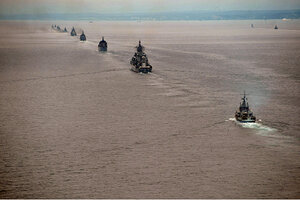Russian Navy returns to Arctic. Permanently.
Officials say the arrival of a Russian flotilla at a remote Arctic island is the start of a new, permanent naval presence in the thawing region.

Russian Pacific Navy ships sail near the Sakhalin Island during military exercises on Tuesday, July 16, 2013.
Alexei Nikolsky/Presidential Press Service/RIA Novosti/AP/File
Moscow
Russia is returning to the Arctic, nearly a quarter century after virtually abandoning the region in the wake of the Soviet Union's collapse.
The new determination to defend Russia's Arctic stake was symbolized by an impressive naval operation, widely covered in the Russian media, that saw a task force of 10 warships and nuclear-powered icebreakers complete a 2,000-mile patrol across the formerly icebound coastline. The flotilla was led by the flagship of Russia's northern fleet, the guided-missile cruiser Peter the Great.
The ships arrived at the Novosibirsk (or New Siberian) Islands, near the Lena River Delta, last Thursday, Deputy Defense Minister Gen. Arkady Bakhin said. He said the flotilla’s mission was part of a larger mission for the development and improvement of the Northern Sea Route and the Arctic zone around it.
"We have arrived there or, to be more exact, have returned there to stay because this was originally Russian land," Russian media quoted Bakhin as saying.
In addition to regular naval patrols, Russia is rebuilding a Soviet air base on Kotelny Island off the northern coast of eastern Siberia, which will serve as a bridgehead for restoring Russia's presence along the northeastern sea route that President Vladimir Putin has said may become as "important as the Suez Canal" in the coming decades.
Russia has been making substantial investments in its tattered and often rusting military for more than a decade now. But the new emphasis on the Arctic is driven largely by global warming. Despite a recent episode of cooling, there has been a massive retreat of the ice sheets that formerly made the region practically impassible to shipping and forbidding to most kinds of economic activity.
The fabled Northeast Passage between the Far East and Europe across the top of Russia, which could cut two weeks off voyage times, is rapidly becoming a viable commercial prospect. Previously off-limits resources such as oil, gas, and fisheries are opening up for potential exploitation as the icecaps recede.
Russia has staked claims to about 380,000 square miles of internationally administered Arctic territory, arguing in a 2001 United Nations filing that the Lomonosov Ridge, which constitutes the sea bottom all the way to the North Pole, is actually an extension of Siberia's continental shelf and thus should be considered Russian territory.
In 2007, Russian Arctic explorer Artur Chilingarov laid down the gauntlet to the world by descending nearly three miles to the sea bottom underneath the North Pole and planting a titanium Russian flag there.
"Many countries are starting to lay claims to this region, even some that have no northern presence at all, like China and Brazil," says Viktor Litovkin, military affairs editor of the Moscow daily Nezavisimaya Gazeta. “This has prodded Russia into action, to hang on to our priority and legitimate rights.”
"The Russian leadership has made a political decision to return to the Arctic. We'll be restoring airfields, reviving Soviet-era hydro-meteorological services, and deploying the naval means to convoy ships and defend Russia's economic zone of interests," he adds.
New Arctic air bases will soon be constructed using modern technology to provide "regular, year-round and all-weather" access to the region, Bakhin said.
"We aim to restore polar aviation and its infrastructure, including bases on the continent and on islands," he said.
Despite the military-led nature of Russia's new Arctic thrust, Mr. Putin has insisted that he favors a peaceful division of the polar regions between the major Arctic nations.
Viktor Boyarsky, a Russian polar explorer and director of the State Museum of the Arctic and Antarctic in St. Petersburg, says he's pleased to see the Peter the Great warship once again patrolling Arctic waters that had been long abandoned by Moscow. The region has immense potential and Russia hasn’t begun to tap it yet, he says.
"I'm a man of peace, but this convoy of naval ships is good because it signals the return of life to the Arctic," he adds. “It's not saber-rattling. It's rebuilding.”

